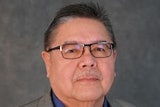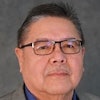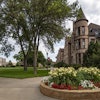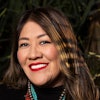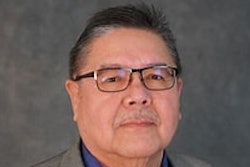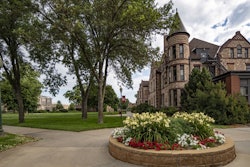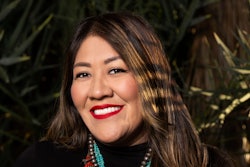ALBUQUERQUE, N.M.
Native American students often struggle
academically at colleges and universities nationwide because the
institutions are virtually foreign environments. As a result, says Pam
Agoyo, director of the National Institute for Native Leadership in
Higher Education, half of the first-year Native American students who
start college leave by the end of their first year.
To deal with this issue, representatives from almost fifty colleges
and universities, including several from Canada, have been coming
together since 1993 to share information and strategies on how to
increase the number of Native Americans graduating from college. And
Agoyo’s institute, which is located at the University of New Mexico,
has now been awarded a two-year, $350,000 grant to continue its work.
Because there are approximately 500 tribes in the country, Mary
Belgarde, a professor at UNM, says that it is impossible to generalize
about Native Americans in higher education.
One characteristic that is applicable to Native American students,
however, is that many leave and return to college several times. While
many institutions and administrators refer to this practice as
“dropping out,” some researchers say that is an inaccurate description.
According to Belgarde, many Native American students don’t see college
as something you do for four to five years. Instead, they see it as a
lifelong commitment.
Mary McAfee, whose dissertation research at the University of
Colorado looked into the college-going patterns of Native Americans
pursuing degrees in science, math, engineering and business, says she
refers to that practice as “stepping out.”
“American Indian students tend to go to school by stepping in and
out more than once before receiving their baccalaureate degree,” says
McAfee. “This has lots of implications for students and institutions,
particularly when it comes to financial aid.”
Cultural Identity
McAfee has found that cultural identity is the key to students
stepping in and out of college. Although the assumption may be that the
students who are more culturally traditional have more trouble in
school, she says: “However, my research shows that the more grounded a
student is in [their] traditions, the greater the chance of graduating.
Those torn between two worlds have more trouble staying in school. Many
of those who are [culturally] traditional have ceremonies in their
village before they go off to college. It’s such an honored thing to go
to college.”
Belgarde says her research concurs with McAfee’s: “Success depends on how strong students are tied to their culture.”
The biggest problem in researching Native Americans is finding the
statistics, according to McAfee, who points out, “There is no uniform
way of tracking students, particularly American Indian students.” After
travelling to nine colleges to do research, she says, “None measured
attrition, retention, graduation, or persistence rates.” And because
Native Americans are only .8 percent of the population, she is always
leery about statistics that claim to measure Native American
participation.
One of the things that is bothersome to Native American students is
that many times they are expected to be spokespersons for their
culture, according to Belgarde.
“They are often called upon to present their cultural point of view
– to be cultural emissaries” for all American Indians, says Belgrade.
“Because of the literature on American Indians, Indians are expected to
conform to stereotypes, thus all Indians are supposed to be alike and
everyone within a tribe is also supposed to be alike.”
Belgrade points to several other impediments to the education of
Native Americans. For instance, when there’s two Indians in the
classroom, they are expected to agree with each other. They are often
not allowed to present evidence for their arguments from sources other
than those which are documented by individuals with a Ph.D. after their
names – a requirement which often causes stress, she says.
Additionally, non-Native American children are taught to actively
participate in discussions whereas Native Americans are taught to be
active listeners.
“They don’t speak up unless they have something significant to say,”
notes Belgrade, who adds that other students may jump up and down
simply to get noticed. “For some, that’s important.”
Another thing many students note, says Belgrade, is that there is
little connection between what they study in high school and in
college. Ultimately, that places a lot of stress on Native American
students, who bring different and unique pressures with them to the
campus.
Comfort Zones
One of the projects that seems to work very well is Stanford’s
six-week summer program for Native Americans. There they get a sense of
what’s expected of them in college, and they form bonds which last
throughout their college years, says Belgarde. Because they are from
different nations, they have created an inter-tribal support system
among themselves.
“They created their own community within a White structure. That
helps them stay longer in school and graduate,” she says. “I don’t know
if it’s magic, but it works. Before the summer program, the retention
rates were dismal. Now they are much higher or stabilized.”
According to Winona Simms, director of the American Indian and
Alaska Native program at Stanford, the summer program helps students
learn the system, teaches them how to get financial aid, and helps them
meet professors.
Although UNM has more Native American students, it does not have the
same atmosphere as Stanford because, according to Belgrade, many of the
students at UNM are from nearby reservations, are commuters, and are
older. They are not as isolated. And although the university has
various programs that assist Native American students, what is more
important is the fact that UNM has twenty-six Native American
professors.
“Seeing their role models is part of the pipeline,” Belgrade says,
who notes that many colleges don’t even have one Native American
professor.
Additionally, some institutions are not supportive of Native
American programs, and do not carry native literature in the library.
And some colleges which say they are supportive of the plight of Native
American education are only committed to the money, says Belgrade – and
when that’s gone, so is the support.
Mike Hanitchak, director of the Native American Program at Dartmouth
College, says the experiences at his school are very different from
those at most other colleges. For one, despite the fact that Dartmouth
is located in the Northeast, far away from large Native American
communities, Native American students come from throughout the
Americas. He is studying whether being isolated has a positive effect
on the students there.
“We know [the isolation] has a negative effect in terms of home
sickness, but that same distance doesn’t allow students to just pick up
and go home,” he says, adding that although there is no data, the topic
“has crossed our minds.”
Because of the isolation, Hanitchak’s center attempts to provide a
comfortable environment, which is essential at a college that is
radically different – socially and physically – from what Native
American students are used to attending. Part of the comfort involves
bringing elders, artists, musicians, and families to Dartmouth, for
ceremonies honoring the heritage of Native Americans.
“We try to recreate some kind of comfortable atmosphere and we
provide academic support. The students here don’t drop out because of
academic problems. It’s rare to find students who can’t do the work.
Our retention rate is ten times better than the national average,”
claims Hanitchak.
According to Hanitchak, schools which provide cultural centers do
best at retention: “That’s a big plus… Anything [Dartmouth College]
can do to improve American Indian education – that’s the goal.”
Two Worlds
Stanford’s Simms says: “If there weren’t a problem, there wouldn’t
be a program… You have to understand that education is a traditional
enemy of Indian people.”
The reason for the adversarial relationship, according to Simms, is
the boarding-school experience which forced assimilation and
acculturation upon Native American students. For generations of Native
Americans, education represents a loss of language, family, and culture.
“That doesn’t affect all students, but it’s a legacy,” says Simms. “It’s a lot to overcome.”
Carolyn Fiscus, grants coordinator at Nebraska Indian Community
College, says that UNM’s institute is where she learned that it was
okay to be both a traditional Native American – who participates in
prayer and ceremonies, and believes in her nation’s folklore – and a
successful professional in academia.
“What it does for me is that it has provides for me the support that
was lacking in the academy,” she says. “Everyone who participates in
the institute is like a worker bee, but traditional at heart. Normally,
you have to be one or the other. [The institute] is revitalizing.”
As for the students, Fiscus says that they now “have living proof
that there are choices. You don’t have to compromise your values in a
world of aliens. You can live in both worlds.”
Each student has to be treated as an individual, she says, adding,
“You have to know where they’re really coming from before creating a
recipe for success.”
And she notes that the successful programs are the ones that don’t treat the students like they are in need of help.
“I tell them, ‘You do the legwork, I’ll give you the shortcuts,'”
says Fiscus. “We live a warrior life. We don’t ask for accolades. If
you serve with a good heart, you will get what you want.”
COPYRIGHT 1997 Cox, Matthews & Associates
© Copyright 2005 by DiverseEducation.com
